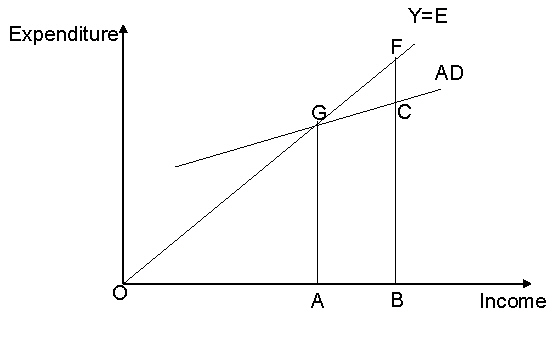Multiple Choice
Identify the
choice that best completes the statement or answers the question.
|
|
|
1.
|
The reported budget deficit refers to
a. | The debt of the federal government. | b. | Government expenditures plus transfers net of
tax revenues. | c. | Interest payments on the primary budget deficit. | d. | The primary budget
deficit plus interest payments on government debt. |
|
|
|
2.
|
If government expenditures are $11 billion, transfers are $7 billion and tax
receipts are $9 billion then the primary budget deficit is
a. | $9 billion. | b. | $5 billion. | c. | $27
billion. | d. | Cannot calculate, need figures for interest payments. |
|
|
|
3.
|
Suppose the nominal interest rate is 2% and the growth rate of GDP is 7%. If the
government maintains a policy of running a constant deficit equal to d% of GDP every year,
what is the approximate value of d consistent with a steady state value of debt equal to twice
the GDP?
|
|
|
4.
|
Ricardian Equivalence says that it does not matter whether the government
finances increased expenditure by borrowing or by raising taxes because
a. | The government must pay back its debt by borrowing more. | b. | Households correctly
anticipate that if the government borrows today, it will have to pay back the debt by raising future
taxes. | c. | Households who pay taxes are not the ones who hold government
debt. | d. | None of the above. |
|
|
|
5.
|
The national debt will rise in a particular year
when
a. | there is a budget deficit. | c. | government expenditure rises. | b. | there is a rise in interest rates. | d. | the level of
income falls. |
|
|
|
6.
|
Given the following values for consumption (C),
investment (I), government spending on goods and services (G), taxation (T) and income (Y), the
equilibrium level of income is
C = 2000 + 0.75(Y-T)
I = 1000
G = 1,500
T = 0.2Y
a. | 5,626. | c. | 11,000. | b. | 7,500. | d. | 11,250. |
|
|
|
7.
|
If, G is government spending on goods and
services, T is taxation, Y is income and c is the marginal propensity to
consume, the balanced budget multiplier can be written as
|
|
|
8.
|
Question 8 and 9 are based on the following diagram
in which AD = C + I + G. Assume that government spending is financed entirely by borrowing and
that no taxes are levied.
 8.
Which one of the above represents
savings?
|
|
|
9.
|
Which one of the above represents the level of
consumption when saving is zero?
|
|
|
10.
|
The neutrality of fiscal policy in the theory of
Ricardian equivalence has been questioned for which one of the following reasons?
a. | Consumers sometimes buy on impulse and do not plan
consumption expenditures. | b. | Lump sum taxes
have no impact of the incentive to work. | c. | Changes in the
rate of income tax impact on consumer spending. | d. | Discounting to
present value is an imprecise calculation. |
|